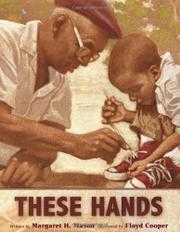 “For all the many titles that appear on segregation and protest for younger readers,” wrote the Kirkus
review, “this one stands tall not just for delving into a piece of
labor history not previously covered, but for its ability to relate
history with heart and resonance.”
“For all the many titles that appear on segregation and protest for younger readers,” wrote the Kirkus
review, “this one stands tall not just for delving into a piece of
labor history not previously covered, but for its ability to relate
history with heart and resonance.”Publishers Weekly called it “a moving study of multigenerational relationships and triumph over discrimination.”
In These Hands, illustrator Floyd Cooper rendered sepia-toned, soft-focus illustrations in oil wash, using kneaded erasers, and they nearly leap off the page. Written by Margaret H. Mason, it is a book about segregation set not in the south, but in unionized northern factories, organized by Democrats; to exclude black Americans from higher-paying jobs. The story shows one man standing with dignity despite his circumstances and people uniting to stand up for themselves. The picture book’s roots in rarely told history will widen the audience of this moving title to older readers, too.
Joseph’s grandpa could do almost anything with his hands. He could play the piano, throw a curveball, and tie a triple bowline knot in three seconds flat. But in the 1950s and 60s, he could not bake bread at the Wonder Bread factory. Factory bosses said white people would not want to eat bread touched by the hands of the African Americans who worked there. In this powerful intergenerational story, Joseph learns that people joined their hands together to fight discrimination so that one day, their hands—Joseph’s hands—could do anything at all in this whole wide world.
The Process of Floyd Cooper, Illustrator of These Hands (Click on links for the images):
Did you know these hands
used to pluck the ace of spades
right out of thin air?
Well, I can still teach a young fellow
how to do a waterfall shuffle
—yes, I can.”
Beautiful, touching pictures, almost like photographs, combine with a beautiful, touching story to make a remarkable book.
Comments